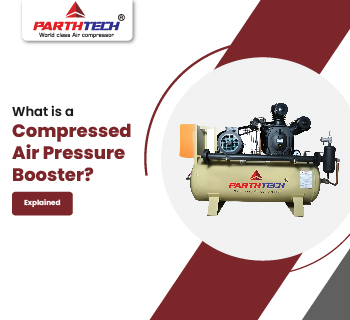-
Call
-
Whatsapp
9825014048
-
Location


Blog


BLOG

Compressed Air Pressure Booster
Maintaining the correct air pressure is crucial for efficiency and performance in many industrial applications. Sometimes, the air pressure from your compressor needs to be increased for specific tasks. This is where a compressed air pressure booster comes into play. Understanding a compressed air pressure booster and how it works can help optimise your operations.
A booster system is a piece of machinery that adds more compression stages to an existing compression system to raise the air pressure. With the help of a booster air compressor, air pressures as low as 80 to 150 PSIG can be increased to 2000 PSIG.

What is a Compressed Air Pressure Booster?
A compressed air pressure booster is a device that increases the pressure of compressed air coming from an air compressor. It takes the existing compressed air and raises its pressure to a higher level, making it suitable for applications requiring higher air pressure than the central compressor.
Why use a Compressed Air Pressure Booster?
Using a compressed air pressure booster offers several benefits:
-
Enhanced Performance: Some tools and machinery require higher air pressure to function correctly. A booster ensures these devices operate efficiently.
-
Cost-Effective Solution: A booster can be a more economical way to achieve higher air pressure than investing in a new, more powerful compressor.
-
Flexibility: Boosters allow pressure levels to be adjusted for different applications without changing the entire compressor setup.
How Does a Compressed Air Pressure Booster Work?
A compressed air pressure booster works by taking in compressed air from the primary compressor and further compressing it to a higher pressure. Here's a simplified breakdown of the process.
1. Air Intake:
The booster receives compressed air from the central compressor. This air is already pressurized but needs to be boosted to a higher level for specific applications.
2. Compression:
Inside the booster, the air undergoes an additional compression stage. This is typically achieved using a reciprocating piston or a diaphragm mechanism, which compresses the air to the desired higher pressure.
3. Cooling:
During the compression process, the air can become heated. Many boosters include cooling systems to ensure the air remains at a stable temperature, which helps maintain efficiency and prevent damage to equipment.
4. Output:
The boosted air is then delivered to the tools or machinery requiring higher pressure. The output pressure can often be adjusted to meet the application's specific needs.
Types of Compressed Air Pressure Boosters:
Several compressed air pressure boosters are designed for different needs and applications.
Single-Stage Boosters:
These are used for moderate pressure increases and are suitable for general industrial applications.
Two-Stage Boosters:
These provide higher pressure levels and are used when significant pressure boosts are needed.
Diaphragm Boosters:
These are ideal for applications requiring oil-free air, such as food and pharmaceutical industries.
Piston Boosters:
Because they are sturdy and can supply high-pressure air, these find widespread use in many industrial environments.
Applications of Compressed Air Pressure Boosters:
Compressed air pressure boosters are used in a wide range of industries and applications, including:
Manufacturing: For operating high-pressure tools and machinery.
Automotive: In tyre inflation systems and pneumatic tools.
Pharmaceuticals: For processes requiring clean, high-pressure air.
Food and Beverage: For packaging and processing applications.
Aerospace: In testing and manufacturing of high-pressure components.
Maintaining Your Compressed Air Pressure Booster:
To ensure your compressed air pressure booster operates efficiently, regular maintenance is essential:
Regular Inspections: Ensure no leaks, wear and tear, or other problems.
Lubrication: Ensure moving parts are adequately lubricated to reduce friction and wear.
Filter Replacement: Replace filters as recommended to maintain air quality and prevent contamination.
Cooling System Check: Ensure the System is working correctly to avoid overheating.
Conclusion:
A Compressed air pressure booster is a valuable tool for industries that require higher air pressure than their central compressor can provide. By understanding how these boosters work and maintaining them properly, you can enhance the performance of your tools and machinery, ensuring efficient and cost-effective operations. With the right booster, you can meet your specific pressure needs without requiring a complete overhaul of your compressor system.


FAQs

Frequently Ask Questions
If your existing air compressor cannot meet the pressure requirements of your applications, a booster is a cost-effective solution to increase air pressure.
Consider factors such as the required output pressure, air quality needs, and specific application requirements. Talk to an expert to choose the best booster for your requirements.
Most boosters can be used with standard air compressors, but compatibility and the booster's ability to handle the compressor's input pressure must be ensured.
Regular inspections, lubrication of moving parts, filter replacements, and cooling system checks are essential to maintain the efficiency and longevity of your booster.
Noise levels can vary depending on the booster's type and model. Some versions are engineered to be less noisy, so consider this factor if noise is a concern.
